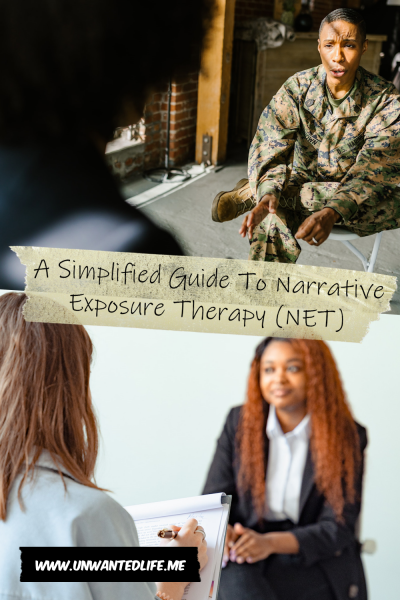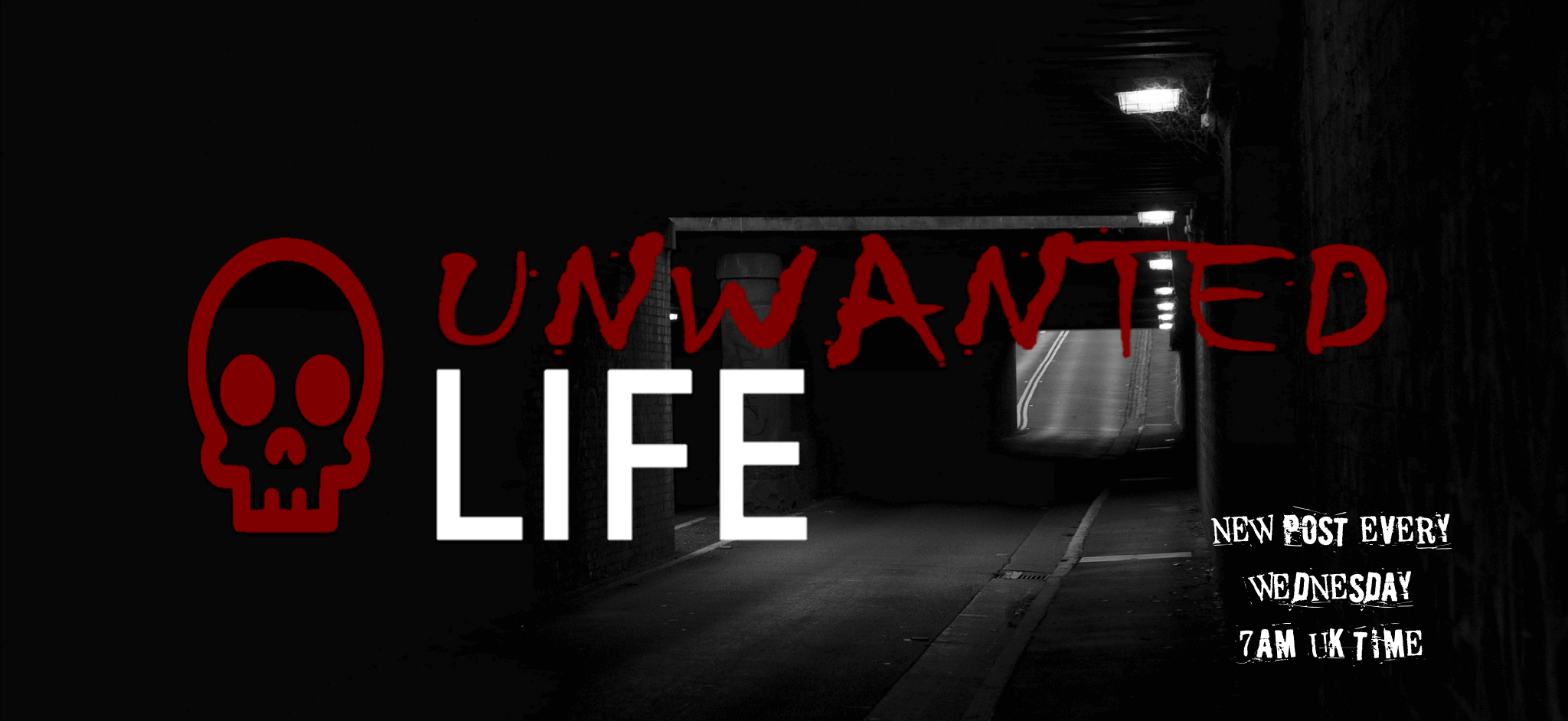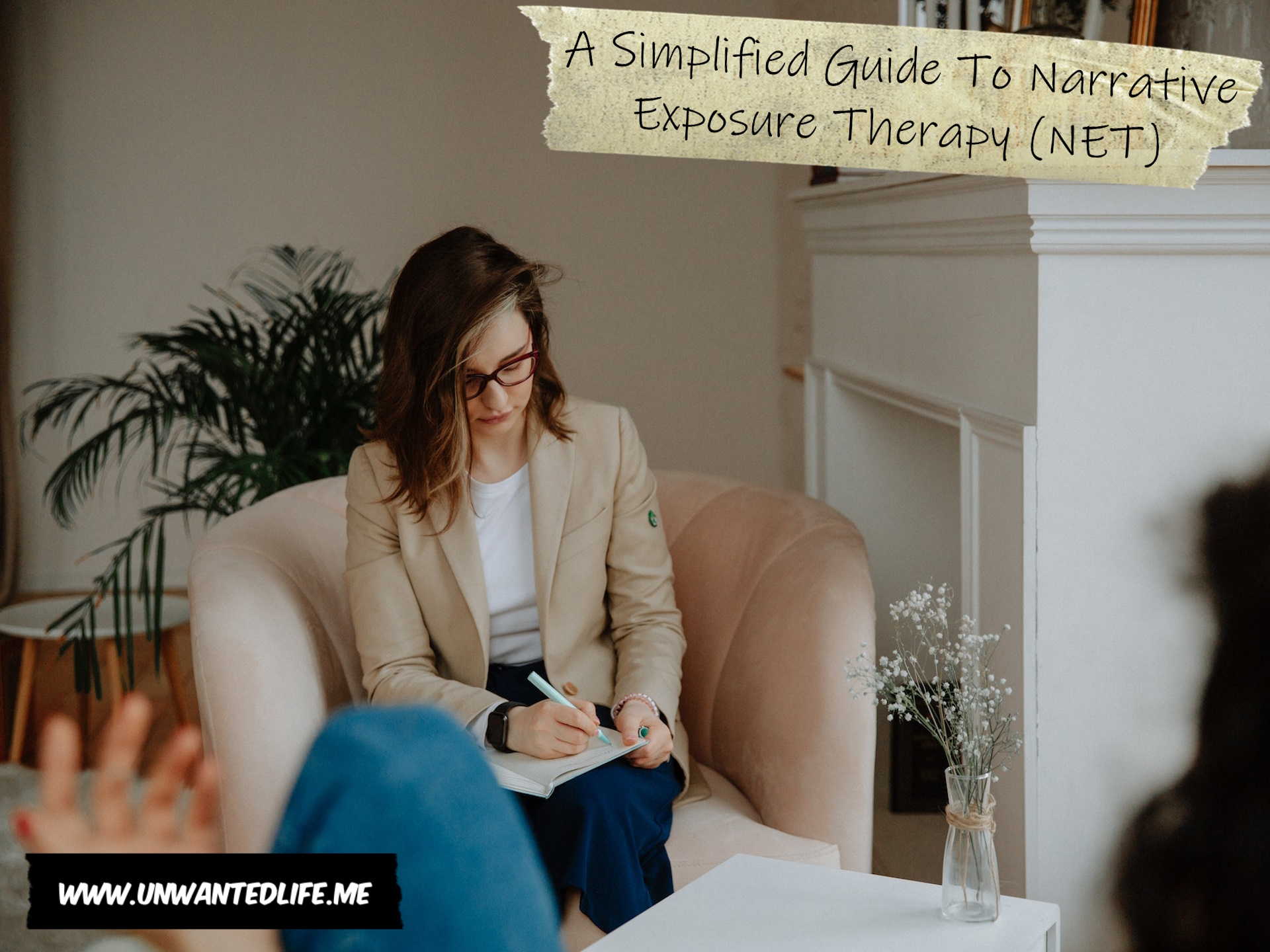Narrative exposure therapy was something my supervisor suggested I look into because of my interest in exposure therapy. As such, it seems like a good opportunity for me to learn something while helping you learn about this form of therapy, too. I hope you enjoy learning about narrative exposure therapy.
What Is Narrative Exposure Therapy?
Narrative exposure therapy is a trauma-focused cognitive behavioural psychotherapy designed to help survivors of trauma, torture, and other atrocities (Schauer et al., 2011). Basically, narrative exposure therapy is used to treat trauma and post-traumatic stress disorder (PTSD).
The goals of narrative exposure therapy are to reduce PTSD symptoms like flashbacks, nightmares, and hypervigilance. It does this by helping people emotionally process traumatic memories and make meaning from them through repeated exposure and narration of the memories within the context of their life stories.
This treatment helps people establish a coherent life narrative in which to contextualise traumatic experiences. This is done by reframing a person’s life story, so it’s not solely about the traumatic experience because we’re more than a single event or a series of traumatic events. According to the APA, it is understood that the story a person tells themself about their life influences that person’s wellbeing and how they perceive their experiences.
Multiple studies have demonstrated that narrative exposure therapy is effective in reducing PTSD, depression, and anxiety symptoms among survivors of war, refugees, victims of sexual violence, and others exposed to severe trauma (Mørkved et al., 2014).
In short, it’s about helping people from letting their trauma define who they are and colouring everything that comes afterwards. And, it could even be used to prevent a traumatic event from developing into PTSD.
How Is Narrative Exposure Therapy Is Used
A therapist will first help their client to identify the traumatic events that they want to talk about. Then, the therapist will guide the client through a detailed narration of each event, starting with the events leading up to the trauma, the trauma itself, and the events that happened afterwards. The therapist will also ask the client to explore their thoughts, feelings, and physical reactions to the trauma while doing this.
A useful thing to remember is to be aware of using anchors while constructing the life story, especially during the trauma part of the person’s life story. This can be done by using the time and place of events to keep emotional and physical responses in the past, allowing the person to avoid losing their sense of the present and their place of safety.
During narrative exposure therapy sessions, the therapist will guide the client to construct a detailed chronological narrative about their life experiences from birth to the present. This focuses extensively on memories of traumatic events. The narrative is recorded by the therapist and reviewed repeatedly with the client to help habituate distressing responses to the trauma memories and integrate them into the client’s biography.
According to PTSD UK, while detailing the trauma and their life story, symbols are often used to guide the person through a step-by-step account of what happened to them. For example, stones are used to mark a particularly negative time, while flowers could be used to mark happier experiences. This can then be modified using a size scale to be representative of the level of emotion. Or, as you see in food like curries that use several chilli pepper images to denote how hot something is, the same can be done here as well. So one flower for mild happiness and five flowers for feeling over the moon.
The use of symbols helps construct a chronological narrative of the person’s life, including both positive and traumatic events. This process can be challenging, but is essential for creating a comprehensive story. The symbols also make it easier to make sure each retelling of their life story contains all relevant details (PTSD UK).
This is then followed by the therapist and client focusing on traumatic events and helping the client recall and describe them in detail. This can be emotionally distressing, but is a crucial step in processing the trauma. This is the exposure part of the therapy.
The client is encouraged to confront their fears and to face the memories of the trauma in a safe and controlled environment. That’s because, through these repeated recounting of the traumatic experiences, the therapy aims to desensitise emotional reactions and facilitate the integration of these memories into the person’s life story.
The aim is to change the ‘hot’ memory full of emotion and make it a ‘cold’ memory with greater logic attached and far fewer emotions attached (PTSD UK). The belief is that it’s the ‘hot’ nature of these memories that leads to intrusive memories, nightmares, and flashbacks because the emotions make the trauma overactivated.
The whole process of narrative exposure therapy is to help people externalise their trauma, viewing it as part of their past rather than a dominating force in their present. This can help reduce symptoms of PTSD. To aid with that, a therapist will teach coping skills and relaxation techniques throughout the sessions to help clients manage distressing emotions and symptoms.
As the therapy progresses, the focus shifts toward reconnecting with the present and building a hopeful future. When the therapy is complete, the client will receive a written narrative as a documented testimony (Lely, Smid, Jongedijk, Knipscheer, and Kleber, 2019).
How To Use Narrative Exposure Therapy As A Form Of Self-Help
There’s not really a mystery about how you could use narrative exposure therapy as a form of self-help, as you just have to follow the guide highlighted above. However, what’s important is to make sure you’re in a good position to do it. And I don’t mean how you might sit while writing out your life story. Any and all work when it comes to trauma comes with risks, but it’s even more risky when you don’t have a therapist to support you through it.
Therefore, before you do this as a form of self-help, you will want to teach yourself some coping skills and relaxation techniques. To help you get started with that, why not check out my article on breathing exercises by clicking here? It might also be a good idea to prepare for this by developing your own cue-controlled relaxation.
Furthermore, it might be a good idea to let someone know that you’re doing this so they can check in on you after you’ve gone through a self-help session using narrative exposure therapy. It’s better to be safe than sorry.
If you’ve taken the steps needed to make using narrative exposure therapy safe as a form of self-help, then it can make for a good journaling task. So, as you would with a therapist, start with a detailed narration of the events leading up to the traumatic event, the trauma itself, and the events that followed. But as you do this, remember to include your anchor points.
Once that has been done, it’s time to include the traumatic events in your life map. So next you’ll want to map out all the good, bad, and boring events in your life story. Remember to include your symbols to make it easier to recount your life story and what good and bad events were important. You could even use stickers to make this easier.

Now you’ll want to focus on the parts that are traumatic so you can help yourself become desensitised to the events. This will allow you to incorporate these events into your overall life story, so they’re nothing more than another event in your life.
So, set aside some time to go through reading your traumatic events as you’ve written them down. This won’t be something you’ll be doing in one sitting, and you may benefit from journaling about the experience after each read-through of the trauma and stating the level of fear you experience each time. This will help you track your progress. I would recommend the often-used scale of 1-10, with 10 being the absolute worst and one being no fear. Self-reflection after each reading is a great way to help change the nature of the traumatic memory and depower it, and journaling is great for doing that.
Remember to make a note of the dates of the events you add to your life story, and make a point of using those dates with each retelling of the traumatic events to help keep the past separate from the present.
Also, remember to use your coping strategies if at any point you feel it’s becoming too much to handle. There’s nothing wrong with ending the self-help session if it’s becoming too much. You can pick it up again once you’ve settled back down. Knowing when to do this is also an important skill to add to your wellbeing toolbox.
Once you feel you’ve reduced the traumatic ‘hot’ memories to ‘cold’ ones, it’s time to reconnect with your present and look to improve the quality of your life. There are many ways to do this, but the one I’m going to suggest is to try using a positive psychology intervention. One of my current favours is writing about one positive thing that happened to you that day and then carrying that on for the next few weeks in a positivity journal. But you could also try mindfulness because it’s great for helping to focus on the present.
Summary
Although narrative exposure therapy has shown promise in helping people recover from severe trauma and regain control over their lives. It may not be suitable for everyone, and the effectiveness of any therapeutic approach can vary from person to person. Because it works with trauma, it does come with the risk of causing harm rather than being helpful, but that’s always the case when working with trauma, regardless of the method used.
Thus, it’s always better to consult a qualified mental health practitioner to determine the most appropriate treatment for a specific individual’s needs. However, not everyone has that luxury, which is why I have shown you how it could be used as self-help.
As always, leave your feedback in the comments section below. Also, please share your experiences with narrative exposure therapy in the comments section below as well. Don’t forget, if you want to stay up-to-date with my blog, then sign up for my newsletter below. Alternatively, get push notifications for new articles by clicking the red bell icon in the bottom right corner.
Lastly, if you’d like to support my blog, you can make a donation of any size below. Until next time, Unwanted Life readers.
References
Lely, J. C., Smid, G. E., Jongedijk, R. A., W. Knipscheer, J., & Kleber, R. J. (2019). The effectiveness of narrative exposure therapy: a review, meta-analysis and meta-regression analysis. European journal of psychotraumatology, 10(1), 1550344. Retrieved from https://www.tandfonline.com/doi/pdf/10.1080/20008198.2018.1550344 and https://www.tandfonline.com/doi/full/10.1080/20008198.2018.1550344.
Mørkved, N., Hartmann, K., Aarsheim, L. M., Holen, D., Milde, A. M., Bomyea, J., & Thorp, S. R. (2014). A comparison of narrative exposure therapy and prolonged exposure therapy for PTSD. Clinical psychology review, 34(6), 453–467. Retrieved from https://doi.org/10.1016/j.cpr.2014.06.005 and https://targethiv.org/sites/default/files/Morkved2013ReviewofPE.pdf.
Schauer, M., Neuner, F., & Elbert, T. (2011). Narrative exposure therapy: A short-term treatment for traumatic stress disorders (2nd rev. and exp. ed.). Hogrefe Publishing. Retrieved from https://psycnet.apa.org/record/2011-16922-000.


This is interesting, first time to know about this term and your guide helped me to learn a lot of things about it.
Always happy to people learn. Thanks for commenting
This is the first time I heard of NET. But it sounds like a good way to heal ourselves. Thank you for sharing about it.
Thanks to commenting
Fascinating post. I’ve never heard of this term before. It sounds like it could be useful form of therapy for some people if handled in a careful and professional manner
Thank you
Amazing 😍
Thanks
NET is where I settled with trauma-affected individuals. It matters how we tell our story. What we leave in; what we leave out; and how we integrate that we were harmed
Thanks for commenting
Very informative and well researched! I’ve never heard of this technique and find it seems really worth while. I actually want to try this. Thank you!
Thank you
This is an interesting form of therapy to use. It sounds like it may be helpful. I like how you stressed that it may not be a right fit for everyone.
Thanks for commenting
This is a good blog post. I think I’ve used this in therapy. Keep writing. 🙂
Thanks for sharing